|
|
|
Monticello and Knoxville
Wednesday, June 11 2008
setting: The White Pig Bed & Breakfast, rural Albemarle County, Virginia (37.818395N, 78.679039W)
Gretchen and I woke up fairly early this morning and went walking around the pig sanctuary, encountering pot bellied pigs in various natural settings. From a distance, partially hidden in long grass and flaked with mud, they often looked rather like wild animals of the African savanna. There is a cemetary on the grounds, and we investigated it as well. Then entire farm had been a ruin in the 1950s, and for some reason the fact that the ruin had included a cemetary seemed especially poignant.
We had a lovely vegan breakfast of blueberry pancakes and a convincing yoghurt substitute, while Gretchen and the innkeeper engaged in the sort of banter that two vegans can be counted on to engage in when they know little else about each other. The innkeeper is actually from our part of the world and she had once worked in the fashion industry.
Before we left the Charlottesville area, we had plans to take a tour of Jefferson's Monticello plantation, something neither of us had done since the 1970s. We'd remembered the inventions and narrow staircases but little else. The drive to Monticello took us up State Route 20 past most of those vast farms I'd remembered from my commutes to Big Fun. It's easy to take the beauty for granted, but with Gretchen's fresh perspective I could see it all anew. The vistas are almost too big for Virginia; it's as if they belong in some western state.
As we drove, we were listening to a Charlottesville rock station called "the Corner," which seemed to play an inordinate amount of mid-90s nostalgia music, some of which I have barely heard since the 1990s. The scenery and the music were something of a complete nostalgia package, as if I had been transported back to the time of Big Fun. (Mind you, none of this music had been popular at Big Fun, but it had been unavoidable in the environment.)
At the base of Monticello near the visitor parking lot, we paid our $15/each admission and then rode a shuttle bus to the top. The gentleman driving it had a heavy southern Virginia accent. As with the Scottish accent, his profoundly resonant vowels seemed to devour the consonants on either side to the point that Gretchen had trouble understanding him. Though it's not the accent of the Shenandoah Valley where I grew up, it's a familiar one to me and I have little difficulty understanding it.
Our tour of the house itself wouldn't begin for a half hour, so we jumped onto a plantation tour already in progress along the the south slope in the trees below the main compound. A middle aged white woman, standing before the astounding and nearly mathematically-flat background of the distant Piedmont, was telling an all-white group of tourists about the way plantations and slavery functioned back in Jefferson's time. According to her, slavery didn't initially exist in Virginia and grew out of indentured servitude. Over time, plantation owners (who had all the power and made all the laws) gradually expanded the period of service of their imported workers until it came to be a person's entire life and then the lives of all his or her descendants. She didn't explain how it came to be that these drastic expansions of obligation only affected black servants. More surprising than this history was the revelation that slaves on Jefferson's plantation had some freedom to travel so long as they obtained passes. They could, for example, go into Charlottesville for various reasons. They were still, of course, subject to sale on their master's whim, sales that were unaffected by a slave's marriage or other familial connections. In the grand scheme of thing, Jefferson's reputation as a plantation owner was fairly typical for his time; he was neither especially cruel nor especially indulgent, and he tended to do whatever made the most financial sense. As with most plantation owners, he was perpetually in debt, and slaves were his most lucrative assets. It didn't make financial sense for him to make his slaves unnecessarily miserable, but it didn't make financial sense to respect their marriages and families either.
Though our guide was an avid practitioner of the Socratic method, the house tour was brief and a little disappointing. I would have liked to know more about Jefferson's inventions and the quirks of his architectural mind, foggy details of which still survive in my brain from when I visited Monticello in Third Grade.
The house tour ended out atop the north wing, at a spot from which you can look through a tiny hole cut in the trees and see the rotunda of the University of Virginia, some six miles away in Charlottesville.
We toured the small rooms in the house's wings, some of which had been kitchens and others of which had served as stables and other barn-type enclosures. A couple of the rooms had been remade as visitor bathrooms, though someone had experienced an uncontrolled fecal explosion all over the men's room toilet. I should have taken this as mental conditioning to prepare me for the portapotty horrors I would soon be experiencing at Bonnaroo.
When we were done with our Jefferson fix, we walked through the forest down to the visitor center, stopping just before we disappeared beneath the canopy to marvel at the next hill to west, "Montalto," a part of Jefferson's original plantation that had recently been acquired by the Thomas Jefferson Foundation for $15 million, the same amount as the Louisiana Purchase. Gretchen wondered where all that money could possibly be coming from. The Thomas Jefferson Foundation, she concluded, must have some very wealthy benefactors.
Initially we'd planned to go into Charlottesville for lunch, but now this just seemed like a distraction, so instead we set a course for Tennessee. We decided to stay east of the Blue Ridge down to Roanoke, taking I-64 to US 29 and then heading south towards Lynchburg.
At Lovingston, we pulled off the highway to search for a restaurant. Eventually we came upon Chen's, a Chinese restaurant in a strip mall (37.753013N, 78.878145W). While waiting for our food, we went shopping at an adjacent Family Dollar Store, which had a good many items costing more than a dollar, including a $4 watch and a $6 pair of sunglasses, both of which we bought, along with batteries, possibly-recreational cold medicine, and other Bonnaroo supplies. I should note that the Chinese restaurant managed to mess up our order, bringing out a rice plate covered with shrimp, pork, and perhaps a whole Noah's Ark of other critters. When that was fixed, we sat listening to a pair of working women on their lunch break. Gas prices and babies dominated their conversation. Judging by the beat down cars in the strip mall parking lot, Lovingston is an impoverished part of the world.
For most of our drive past Roanoke into Tennessee, we listened to a cliché-riddled James Patterson murder mystery on CD. It provided me little entertainment, but Gretchen was enjoying it. Her standards for murder mysteries do not appear to be all that high.
We got off the interstate at Knoxville, parked the car, and found our way to its downtown mall, a wide overly-barren expanse of concrete that could desperately use some planters or vegetative islands. After sizing up the restaurant options, we settled on the Tomato Head, which featured a delightful outdoor patio area and a good selection of vegan options. It was possible to go either Italian or Tex-Mex at the Tomato Head, so I ordered a burrito (it was delicious) and Gretchen ordered a vegan pizza. At some point we found ourselves trying to remember what the capital of Tennessee is, and when our waiter didn't know, someone at a nearby table told us it was Nashville.
After dinner, while strolling through more of Knoxville's downtown, a young man approached us and tried to pull that scam where he said he'd been robbed and just needed bus fare. To the standard script, he added that he'd just gotten back from Iraq, that police were harassing him, and that people had been calling him nigger. He must have taken us for white people with lots of liberal guilt. But the scam didn't work with us. He might have done better had he suggested that he was a Nigerian prince.
West of Knoxville, we stopped for the night at a Best Western in Harriman.
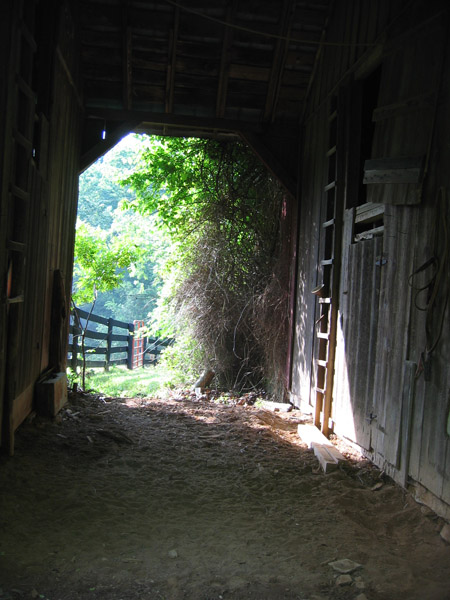
Inside one of the barns.
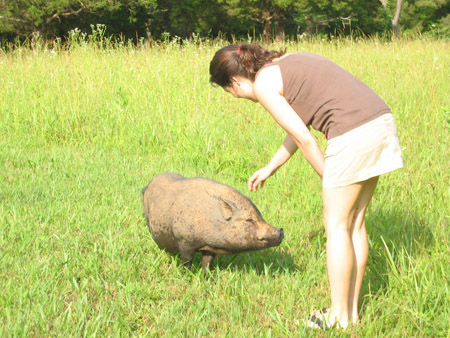
Gretchen with a pot bellied pig.
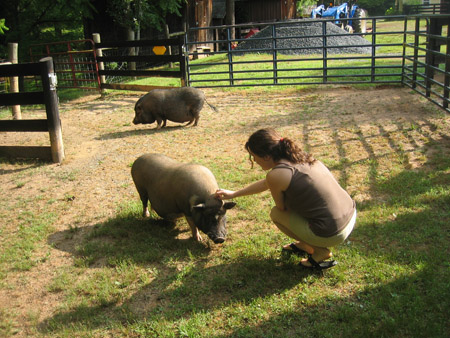
More pigs!
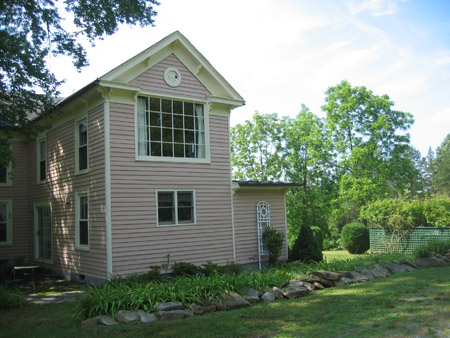
Our room was behind that huge window.
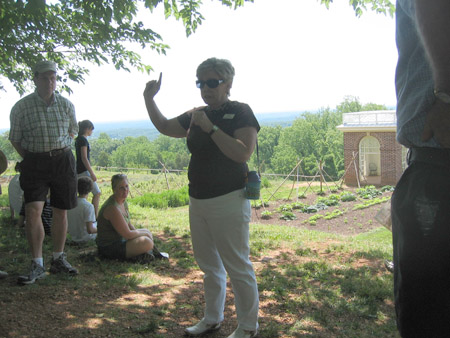
The plantation tour, with the Piedmont in the background.
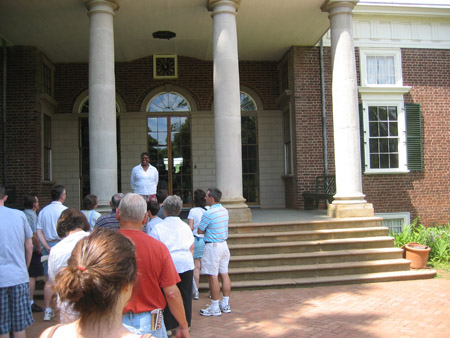
Monticello's lesser portico.
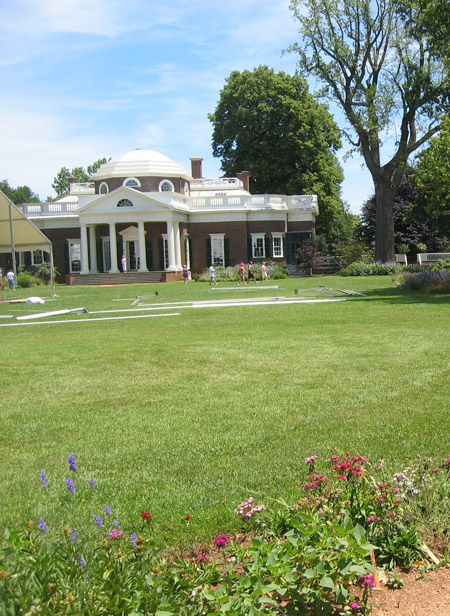
Monticello and grounds. A tent to the left is being set up for some big foundation meeting.
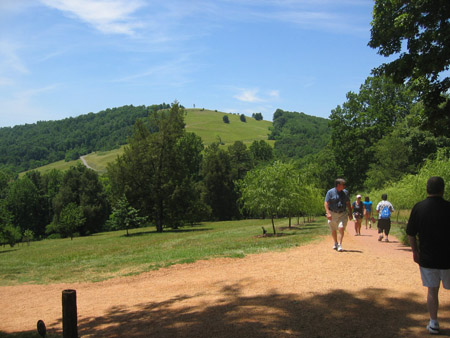
Montalto, the hill to the west of Monticello. It cost 15 million dollars, the same as the Louisiana Purchase.
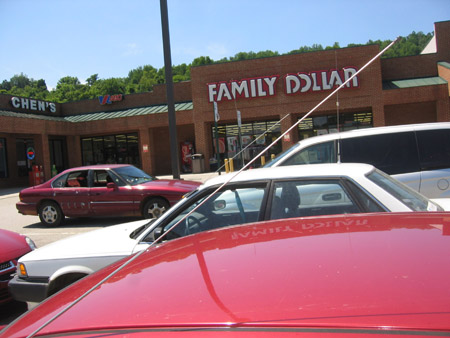
Chen's Chinese restaurant in Lovingston, with a beat down car in the midground.
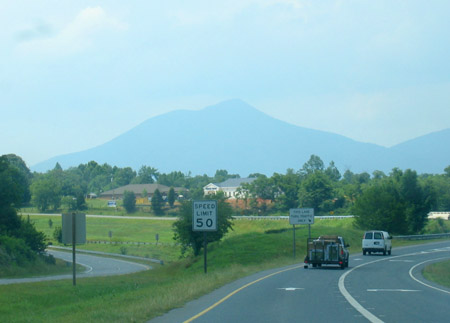
The Peaks of Otter, viewed from Bedford, Virginia.
For linking purposes this article's URL is:
http://asecular.com/blog.php?080611 feedback
previous | next |









